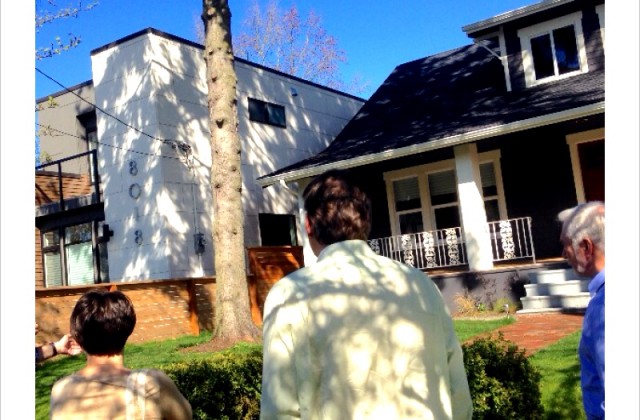Small-Lot Legislation: What Some Neighbors are Saying
I was forwarded an e-mail template being circulated among neighbors aimed at City Councilmembers who will be considering amendments to small-lot legislation on Tuesday. We’re still reviewing the legislation and will likely post comments tomorrow. But I thought it important to respond to the neighbors template here before the hearing at 2pm on Tuesday at City Hall in Council Chambers. So I quote their letter and include a response to each of their points in bold below. We think the amendments and the legislation reflect an honest effort by Councilmember O’Brien to find a solution that addresses real neighborhood concerns and also ensures the future of Seattle’s single-family neighborhoods as a viable place for new people and families to live.
Suggested template:
Dear Members of City Council’s Planning, Land Use and Sustainability Committee:
I appreciate your consideration of the backyard/sideyard house issue that surfaced in 2012. This is a critical issue for Seattle residents.
We agree, it is a critical issue for Seattle residents living here today and those who want to live here tomorrow.
While a good step in the right direction, DPD’s current recommendations need improving to successfully address the problems these structures create in neighborhoods across the city.
The double speak is brilliant: these aren’t structures; they are homes where people live. And they have zero quantifiable impact, at least none opponents have been able to demonstrate.
Here are a few of the items that should be considered:
1–Create a record of all the existing, historic lots: All substandard, secret lots should be made visible to more than just developers. Seattle residents need to be informed.
Passage of the 80 percent rule or a variant of this would make this happen. Any neighbor capable of basic mathematics and with access to the Internet could see what was buildable on their block. All they would have to do is look at King County property records on line, add up the total square footage of the lots and divide by the number of lots. Then the neighbor would multiply that number by .80 to determine whether a lot would be buildable. Only lots at least 80 percent of the average block face would be buildable.
2–Require the use of standard setback regulations everywhere: If developers try to reconfigure a lot into something it was never meant to be, they should be required to use standard setbacks.
It is hard to understand what neighbors mean here by “something it was never meant to be.” This is not only legally challenging but strains the limits of epistemology.
I feel a little like Banquo in MacBeth who asked the witches in one of the opening scenes of the play,
“If you can look into the seeds of time, and say which grain will grow and which will not, speak then to me, who neither beg nor fear your favours nor your hate.”
If neighbors know what “was never meant to be” they have a powerful investment tool that will solve all our problems.
3–Do not allow lot boundary adjustments on historic lots: If a lot isn’t already formatted to allow development, it was never meant to be developed. Allowing lot boundary adjustments creates too much uncertainty for those living in nearby homes.
Again, I don’t know what the neighbors mean by “never meant to be developed.” Such a designation defies the logic behind land use law. I read this as, shouldn’t be buildable “unless I think it should.” As David Neiman asked in his post here, “when you take the sum total of all of the “thou shalt not” clauses in this [underlying] legislation, what is left over for people to build?” The amendments are an effort to define that.
4–Notify the current property owner regarding opinion letters: This notification would help homeowners get the hidden value that developers have taken advantage of for years.
This is sort of like real estate nonsense. The truth is that real estate sellers are not just morally but legally bound to truthfully report the value of what they are selling. It’s hard to see what this requirement would do but give neighbors with lots of time on their hands a way to preemptively file frivolous appeals against new housing.
In addition, please consider the following as you review the recommendations as presented by DPD:
1–Do not implement the 100 Percent Rule: Do not let developers bypass the minimum lot size standards.
The 100 percent rule is actually a compromise from the 80 percent rule and will open up a significant number of lots for new housing; just as importantly it creates certainty for everyone including neighbors who can know what is developable and what is not.
2–Establish an 18-foot maximum height (with 5 feet for pitched roof): Anything taller blocks sunlight and views, robs neighbors of privacy and harms nearby property values.
There isn’t anyone bargaining on this issue in good faith that doesn’t agree that 22 feet is a good compromise, especially since current zoning allows for 37 feet in most single-family zones.
3–Apply the rules uniformly to all undersized lots: The issues these backyard and sideyard homes create are consistent no matter what size the undersized lot.
Agreed. That’s what we’ve agreed to since day one. Our proposal has always included setbacks and height limits that apply to any other single-fajmily lot.
Please protect the interests of all Seattle citizens who live in single-family neighborhoods, not just the interests of developers.
The legislation you are considering will shape Seattle’s future. Please bring consistency and transparency to homeowners in neighborhoods across the city.
It is true. This legislation will shape Seattle’s future, but not just for existing homeowners or developers. More importantly, it sets the stage for the city to grow in a sustainable, predictable way consistent with existing neighborhood character.
Thanks for considering my comments.
Sincerely,


